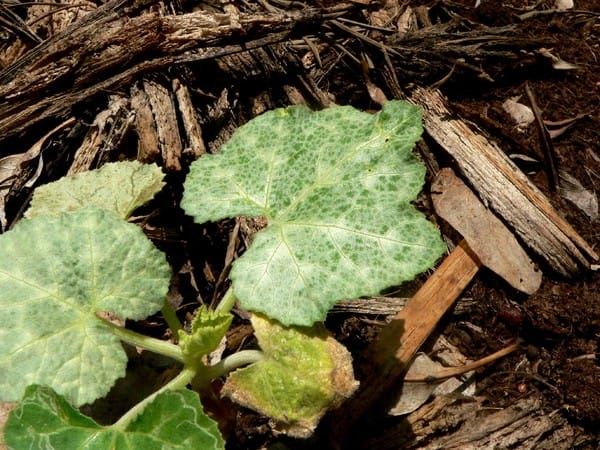Dr B N Vishwanath of Garden City Farmers Trust, in his talks gently but firmly reminds you that we humans are just one of the species on this planet. There are several hundreds of insect species, we have no right to try and exterminate insect-life in the garden or even indiscriminately refer to them as ‘pests’.
At the National Seminar on Organic Urban Gardening in 2010, Dipak Suchde (www.prayogpariwar.net) made a pointed observation that when insects affect a particular plant in the garden, they are a sign that the given plant is not fit for our (human) consumption. This was in response to another participant’s suggestions for pest control. Hearing such a perspective for the first time, I did find it fascinating and it urged me to revisit my understanding of this dimension of organic gardening.

Powdery mildew. Pic: Vinita
More recently at the second Oota from your Thota, I listened in on an interesting session on pest control by Dr Rajendra Hegde from the Vittal Mallya Scientific Research Foundation (VMSRF), that revealed several new insights for me.
One aspect that he repeatedly emphasised was that as organic urban/terrace gardeners we need to focus more on prevention rather than cure. He also cautioned that the presence of insects on our plants does not immediately necessitate an insecticide or pesticide as it is often only a part of the plant or a few leaves that are affected. He urged us to keenly observe the type of insect and the nature of ‘attack’ before shifting to panic mode and seeking out a solution to exterminate the organism completely.
However he also did share a few practical tips and suggestions to deal with commonly faced problems in the garden. For instance,
- Sometimes, just a forceful spray of water is enough to dislodge the insects from the plant.
- Biting insects (beetles and caterpillars) and sucking insects require to be managed differently. (Elementary I agree but I had not given it much thought I suppose!)
- Also that if a regular check and observation of the plants would ensure that one could immediately remove egg masses above and below the leaf surface and destroy only those parts of the plant.
- Separate hibiscus from other plants as it is a host for insects.
He also added that the hot weather is conducive for sucking pests such as mealybugs, aphids, thrips and mites. In this weather the plants experience stress and are more susceptible to pest attack. He advised regular spraying during the hot season which may not otherwise be necessary during the rains.
Neem leaves are readily available everywhere and neem oil in most gardening stores. Neem oil works well against the biting type of insects. He also referred to Soluneem, a product of VMSRF that is a water soluble preparation which is good for sucking type of insect. It is protective and not curative.
As a regular practice to maintain the health of the soil and plants, he suggested spraying soluneem once a fortnight after the first 10 days post sowing and then upto day 40 or so to ensure that the young plant is protected. He cautioned that most natural solutions take 7-10 days to act so they are largely preventive and not curative. They cannot be expected to protect the plant after the organism has attacked.
Part II will discuss how to handle mildew and mealybugs
⊕